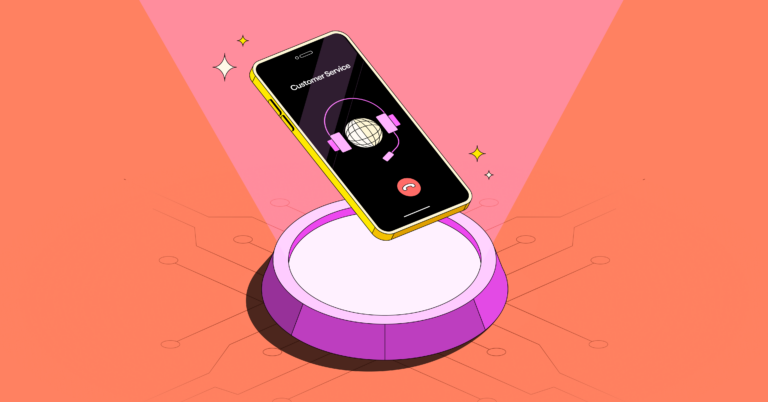It’s the question on every customer service manager’s mind: when to hire more support reps?
For small business owners, this is a tricky question. You have to balance providing your customers with a great experience, yet also think about your budget. Couple that with the necessary ramp-up time, fluctuations in support volume, and finding the “right” person to represent your brand… it can be downright daunting.
On the other hand, if you wait too long, you risk your existing reps becoming buried in emails, tickets, and other support requests. They’ll be overwhelmed, and the customer experience will suffer.
AI-powered customer service can solve many of these challenges. By integrating AI into your customer service workflows, you can handle higher volumes, free up your reps to handle more complex customer issues, and still provide your customers with an outstanding experience.
Advances in AI have been mind-blowing. We’re going to cover seven ways you can integrate AI into your small business and four specific tools to check out. Any of these can be transformative, allowing you to grow without sacrificing quality.
A quick note about what we mean by AI
The artificial intelligence we’ll cover in this article refers to generative artificial intelligence. Unlike traditional customer service AI that simply reacts to queries with pre-set answers, generative AI can create its own responses. This means it can craft more personalized and contextually relevant replies, making interactions feel more human and less robotic. It’s a game-changer for customer experiences!
Benefits of customer service AI for small businesses
AI can solve a lot of the logistical challenges for small business customer service teams, such as staffing and providing prompt, accurate replies to customers. But the benefits go even further, both for your customers and your internal team.
A more efficient and productive team
Customer service teams can do more with less. You can operate with a lower headcount because AI tools can deflect simple, repetitive customer service questions. Your team can also use AI to draft message responses, allowing them to serve more customers in the same amount of time.
Focus on high-value tasks
When AI tackles the easy questions, your reps will get fewer support requests overall. By eliminating low-level tasks, the team can focus on higher-impact work. This might include more complex support questions, 1:1 meetings with customers, or more personalized services.
Increased customer satisfaction
You can handle customer interactions across multiple channels, meeting your customers where they are. Your customers won’t be stuck waiting for a reply because AI can assist your reps. In fact, customers often know their questions don’t require human interaction, and if AI can get them the answers they need immediately, you already have a satisfied customer.
AI can also surface insights across your team’s interactions, allowing you to act on those insights to deliver greater business impact.
Pro Tip: If you’re getting a lot of support tickets, chat, or other customer requests on the same topic, you can turn that into a Help article. Better yet, use AI to help you draft the article.
7 ways growing businesses can use customer service AI
Let’s face it: A great customer service experience is often table stakes. Your customers want a response that’s both prompt and helpful. That might mean integrating AI technology into several areas of your business, depending on the type of service you provide.
1. Provide a friendly chatbot to your customers
No one wants to get stuck in “chatbot hell.” We’ve all been there: a predefined menu of issues, none of them quite match the problem we’re having.
But AI-powered chatbots are an entirely different experience. “Chatbots are better than ever and can allow your customers to self-serve using natural language fast,” says Craig Stoss, Director of CX Transformation Delivery at PartnerHero. These bots are trained on your knowledge base, past support conversations, and brand guidelines.
US-based airline JetBlue partnered with technology vendor ASAPP to provide an AI chat solution. As a result, the contact center saved more than 73,000 hours of rep time in a single quarter. On average, the customer service chatbot saves about four-and-a-half minutes per chat. Think about what that could mean for your own business.
According to Zendesk, over 70% of customers believe conversational AI and chatbots will help them get responses faster and are helpful with simple customer issues. AI-powered chatbots can deflect easier questions so a human rep doesn’t need to be involved at all. These bots also offer a self-service option to your customers; they’re not waiting for a human rep to be available.
2. Help your customer service team deliver better answers faster
Support reps are often held up if they have to search for responses to customer questions. Whether your product is complex or you have a mountain of internal documentation (or both), your reps get “stuck.”
AI-powered rep-assist tools look at historical tickets, published articles, saved templates, and other internal resources to find the right answer. These tools then draft a recommended response for the support rep, tailored to the specific case. For example, an AI-assisted app called RightPage integrates with ticketing powerhouse Zendesk to help reps resolve tickets faster and more accurately.
“These tools are especially useful for newer support team members who aren’t as familiar with your internal resources,” says Sunny Tripathi, Senior Operations Manager at OpenPhone.
Overall, you can expect a faster first response time with rep-assist tools. And if your customer service is subject to SLAs, you’ll be able to better meet the requirements.
3. Draft email and text messages faster to your customers
When your customer service team is drafting the same response over and over, it’s not a good use of their time. Sure, you might have templates, but they still have to search for the template and add it to an email or text message.
AI can deflect email and text responses by drafting or suggesting replies and keeping the responses on-brand. With basic tickets handled, your team can focus on more challenging cases. Machine learning can help AI responses improve over time.
Octopus Energy, a global sustainable energy company, added generative AI to its customer service platform to draft email responses. The application replies to a third of all customer inquiries. In addition to freeing up time, these emails had 18% higher customer happiness scores compared to responses generated by humans.
Support teams can leverage tools like OpenPhone for AI-generated text message responses. OpenPhone uses AI to automatically suggest 2-3 relevant replies based on the context of the conversation. You can also prompt OpenPhone’s AI to generate a message, and if you want to use that particular response again, it can be saved as a snippet for the team.
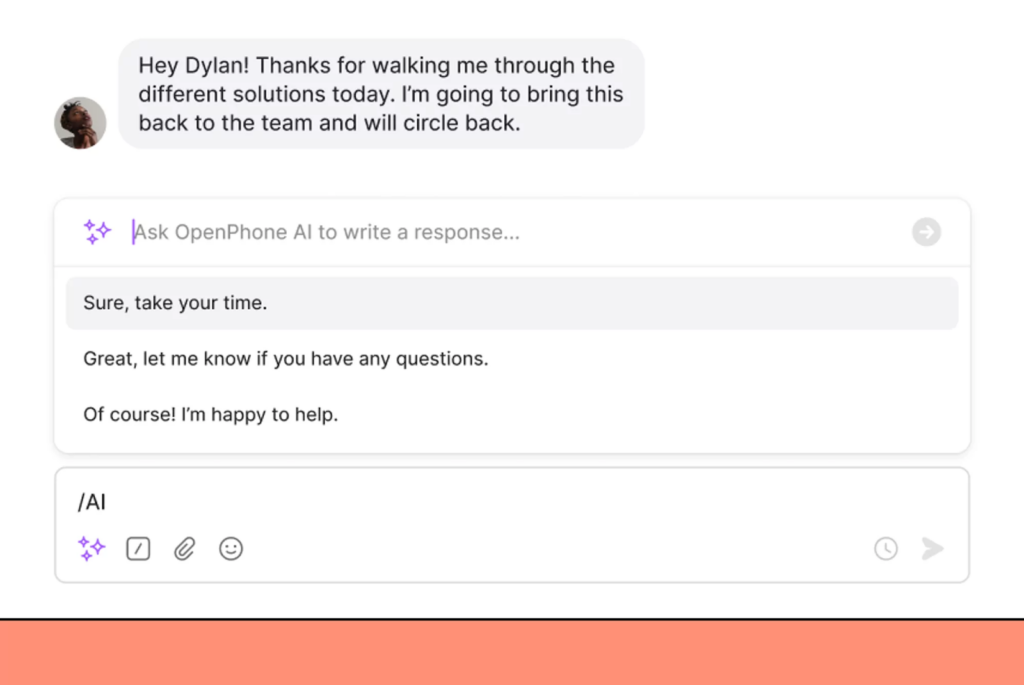
4. Translate support requests from international customers
If your customer base is global, either today or in your plans for the future, you can use AI to offer multilingual support. Tools like Lokalise provide real-time language translation for your support conversation in chat and email. AI translation tools can provide responses that are accurate and stay on-brand.
By providing support in your customers’ native language, you can stand out from the competition and build customer loyalty. You can also expand your reach without needing internal human resources to support additional languages.
5. Quickly get context on past conversations with AI summaries
Exceptional customer support goes beyond simply answering the customer’s questions. You’ll stand out if your team can provide a response based on additional context about your customer and their business (particularly important for B2B customer service).
You can use AI to summarize your calls, whether they’re support calls or other customer meetings. You’re not only able to review the history of interactions with the customer, but you can get insights into the customer’s business and the challenges they’re facing.
Customer service reps can quickly get up to speed using OpenPhone’s AI-generated call summaries, a bullet-point list of what was discussed. They can also review a full call transcription to see exactly what was discussed and reference the topics in conversations with customers.
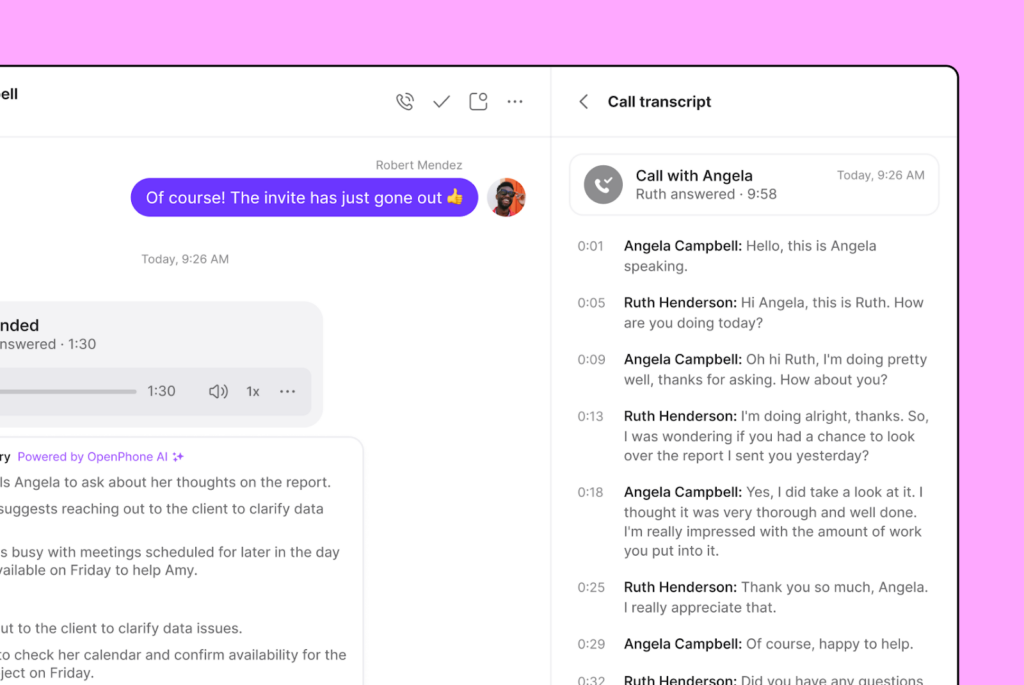
6. Proactively showcase your services to potential customers
Relationships begin long before your customers sign a contract. When a customer makes an inquiry to your company, a word-vomit response of all your products and services feels impersonal. Yet customizing each reply can be time-consuming.
You can use AI to generate personalized replies based on the potential customer’s needs. For example, digital marketing agency 5K Media provides customized business strategy templates to prospective customers with an in-house AI tool. These templates are a starting point for a conversation with the 5K Media team. “The potential client might not have the resources to put the plan into action,” says Pam Abreu, Director of Client Relations at 5K Media. “We provide an opportunity to schedule a consultation with a member of our team to review what we have just put together and have the real humans do the work.”
Flow Digital, a workflow and automation consulting firm, uses AI to personalize responses to website inquiries. Instead of replying with a subject line of “Your Inquiry,” AI customizes the subject line to reflect Flow Digital Services, such as “Re: CRM Setup.” Since making the adjustment, Flow Digital has seen email open rates increase by 30% and also noticed an uptick in customer engagement and satisfaction.
7. Surface important CX insights and analytics
One of the hardest parts about overseeing customer interactions is channel management. According to McKinsey, an estimated 75% of customers use multiple channels in their ongoing experience. The same customer might use email support one day, a chatbot the next, and a social media platform the day after that. You have to be able to link these experiences to get an overall customer sentiment analysis, whether it’s for that single user, an entire company, or your customer service interactions as a whole.
“If we don’t have an interpretive, AI-based analytics tool, we’ll be very limited with what we can analyze because there’s so much feedback to go through,” says Tripathi. “With an analytics tool, you can really look at all your feedback. Tripathi also points out that an analytics tool can review both positive and negative feedback.
With cross-channel AI analytics, you can encompass all touchpoints, from self-service channels to rep-supported operations. “Connecting all of your tools to an intelligent support operations platform that can take data from across the customer lifecycle,” says Stoss. “It can then give you insight into gaps in your process, or areas where you can improve will allow you to fix problems you may not even know existed.”
4 customer service AI tools to consider
If you’re convinced that AI can empower your customer service team (and we hope you are!), here are some tools to check out as you begin to explore your options.
1. OpenPhone: The best phone system with AI features
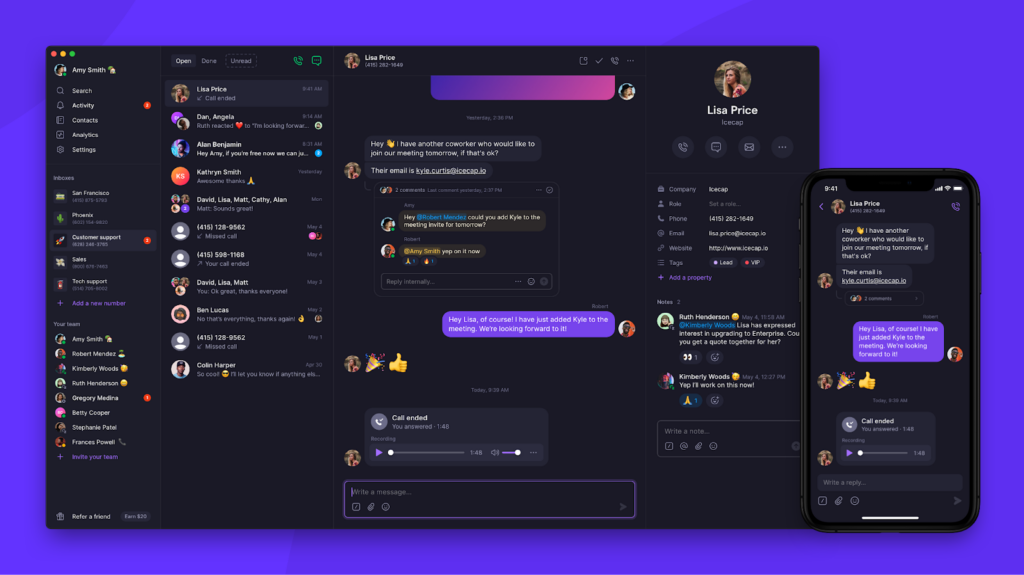
OpenPhone powers small businesses with calling and text messaging services. If you’re looking for an AI-powered phone system for your business, OpenPhone is the right solution for you. As we mentioned before, AI features such as suggested text responses, transcripts, and call summaries can make your customer service teams more productive and efficient.
OpenPhone also has custom properties and contact notes to further personalize your service to customers. It’s a phone solution that gives your team the right context and the right messaging to build deep relationships with your customers. OpenPhone offers desktop, mobile, and web apps in an easy-to-use VoIP solution, so your team can communicate with your customers from anywhere.
Try out OpenPhone today with a seven-day free trial.
Pricing: $20 per user per month for the Premium plan, paid annually
2. Tidio: The best AI chatbot solution for small businesses
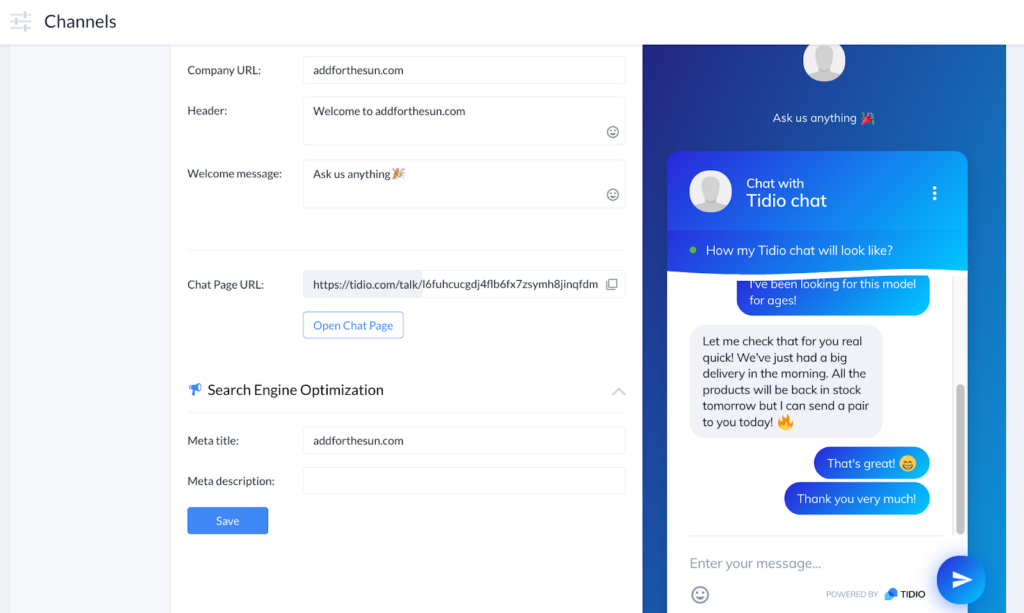
Tidio’s Lyro AI is a chatbot for small businesses. Lyro crawls through your support content to offer personalized answers to basic support integrations. The Reply Assistant feature allows customer service reps to respond with basic answers, and then the AI turns them into fully fleshed-out responses.
Lyro integrates with your help desk (Zendesk, Freshdesk, Intercom, and others), so you don’t have to add an extra standalone tool to your tech stack.
Pricing: Depends on the number of AI-powered conversations, but starts at $29 per user per month
3. Zapier: The best AI-powered automation tool
Zapier allows businesses to connect different tools to handle repetitive tasks. You can integrate your tech stack and start building automation within minutes.
The AI workflow builder allows you to automate customer service workflows using natural language to describe your need, such as connecting Calendly to OpenPhone.
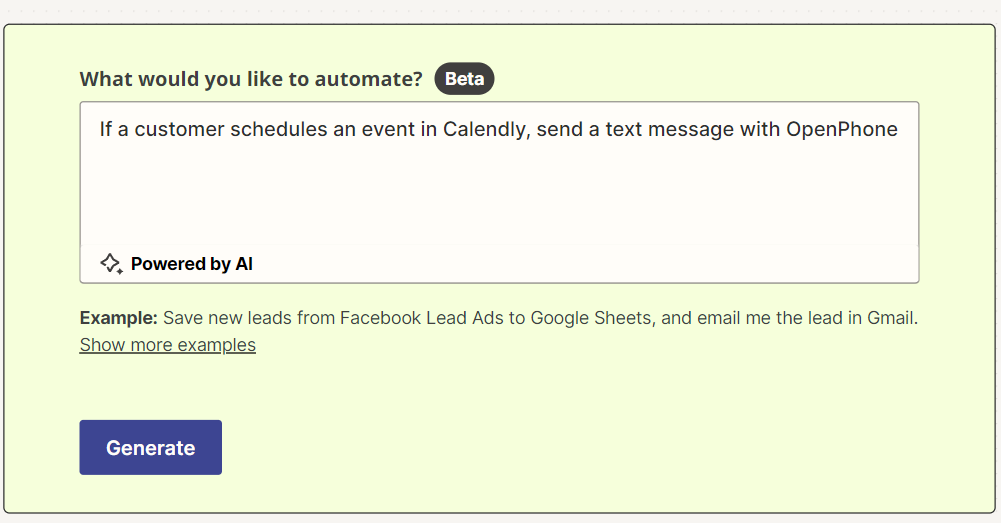
Zapier’s AI will automatically build the necessary workflow.
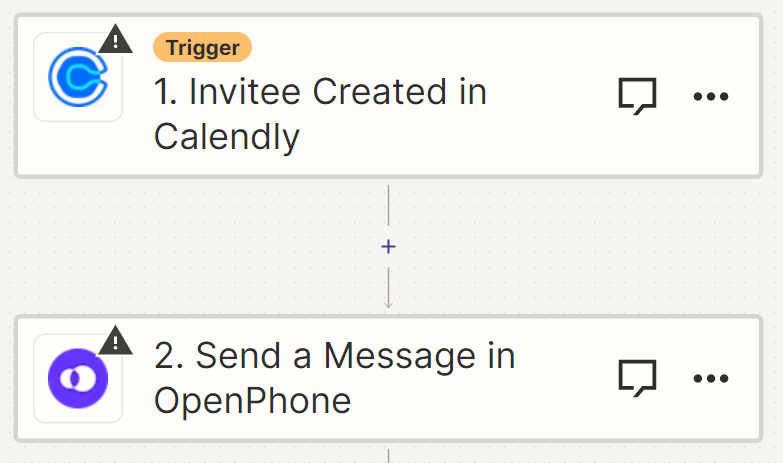
Zapier can connect thousands of different tools, from CRMs to email to ticketing solutions. You can also connect OpenAI’s GPT-3 to add AI responses into your workflows.
Pricing: Starts at $19.99 per month, billed annually, for 750 tasks/month
4. ChatGPT: The best AI writer for small businesses
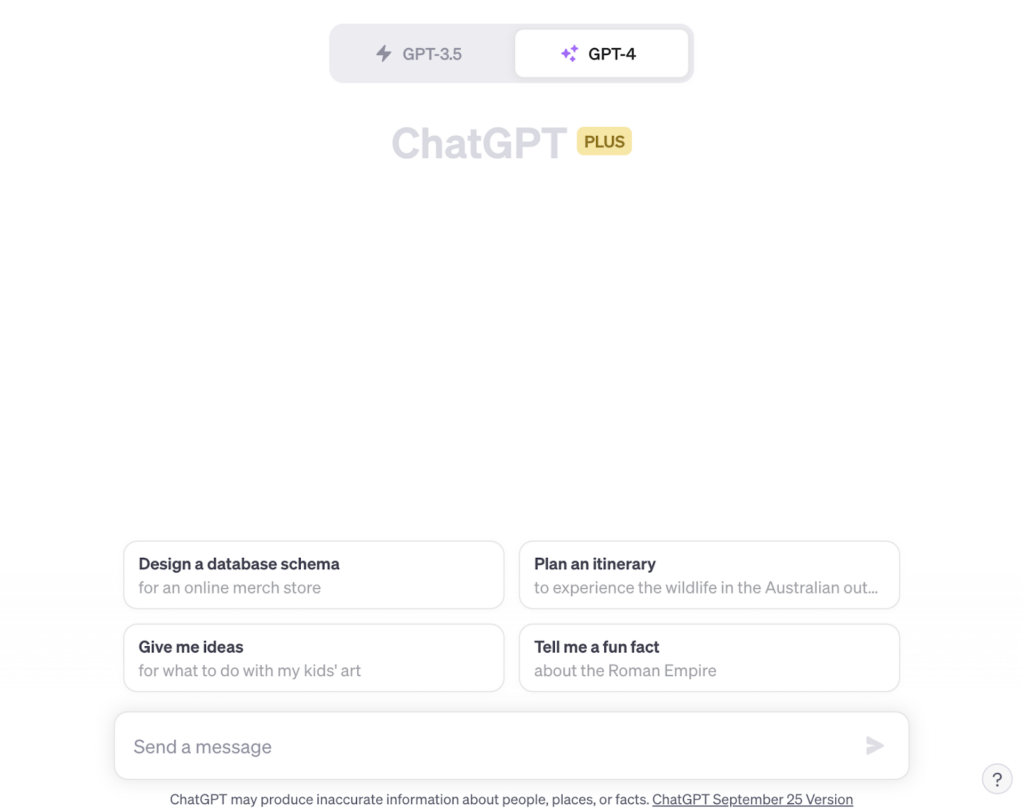
ChatGPT is a powerful generative AI platform from OpenAI. The latest version (GPT-4) can easily handle writing tasks for small businesses, including responding to emails.
ChatGPT stands on its own with a user interface where you can enter a prompt (“Rewrite this email for me”) and get a response. It’s also the backbone of many business AI writing tools, such as Jasper AI.
Pricing: Free, or $20 per user per month for access to ChatGPT Plus, which gives access to GPT-4
Start offering AI in your customer service with OpenPhone
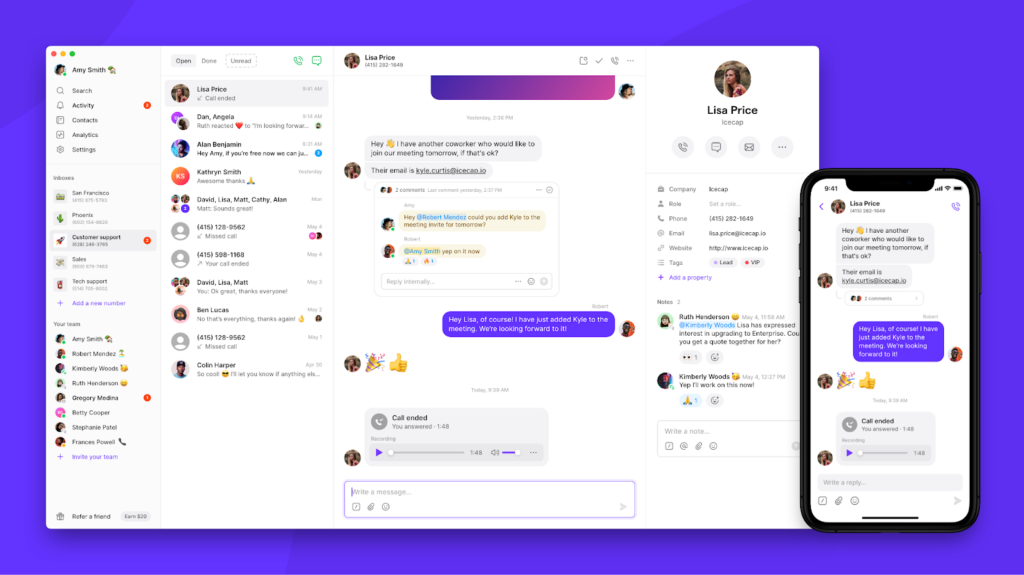
While the world of AI is undoubtedly exciting, it’s important to remember you can’t implement everything at once. Even though your customer service reps will ultimately benefit from AI, it’s still a process change you’ll need to work through.
Prioritize new product implementation that will benefit your customers and your business the most. Also, select a product that allows your team to see how AI will make their jobs easier.
OpenPhone’s AI features are easy to use in your support interactions. Collaborative features can also help your support team, such as phone menus to route calls, simultaneous ring for shared responsibility for incoming calls and text, and internal threads to loop in relevant team members.
You can see these features in action with a 7-day free trial of OpenPhone. Click here to get started.
FAQs
AI can help your customer service reps answer inquiries more quickly by drafting email replies or providing suggested responses. AI can also interact with customers via a chatbot, freeing up your reps for more important tasks.
Generative AI is built on the foundation of a large language model (LLM) trained on vast amounts of text-based data. When presented with a query or prompt, generative AI provides a nuanced response based on the context of the prompt and patterns in similar responses from the training data.
Think of AI as a virtual assistant that can take what it has learned and craft new, contextually relevant content. This makes AI adept at handling diverse and dynamic customer interactions.
